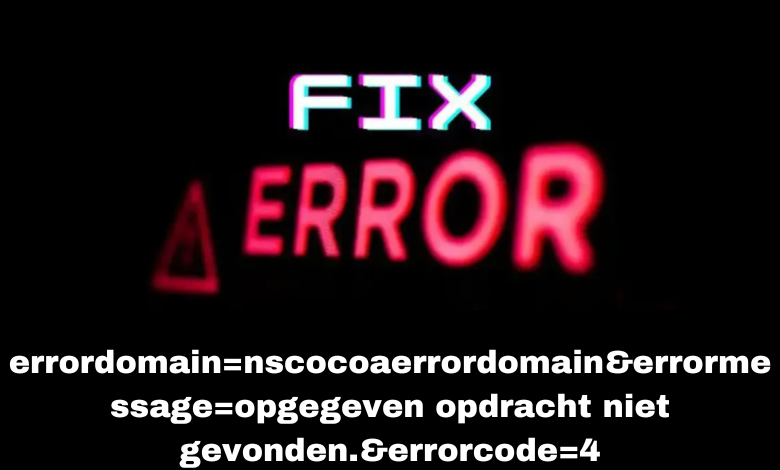In the world of macOS and iOS development, the NSCocoaErrorDomain represents a fundamental component for diagnosing and understanding the myriad of issues that can emerge during the lifecycle of an application. The error message “opgegeven opdracht niet gevonden,” which translates from Dutch to “specified command not found,” presents a particularly intriguing case associated with Error Code 4. This errordomain=nscocoaerrordomain&errormessage=opgegeven opdracht niet gevonden.&errorcode=4 serves as a critical signal to developers, indicating a miscommunication or a missing element in the execution chain of commands.
Understanding Error Code 4: The Command Not Found Issue
Error Code 4 in NSCocoaErrorDomain is particularly significant because it deals directly with the absence of a specific command. This error typically arises when an application attempts to execute a non-existent command or access a missing resource, often due to typographical errors in the code, misnamed files, or commands that someone has moved or deleted. As a result, the system returns an error message stating “specified command not found,” thus alerting developers to the missing link.
Errordomain=nscocoaerrordomain&errormessage=opgegeven opdracht niet gevonden.&errorcode=4: The Role of Error Codes in Efficient Debugging
Efficient handling of Error Code 4 requires an understanding of the underlying issues that could lead to such errors. Developers must rigorously check their code for inaccuracies in command names, paths to resources, and ensure that all referenced elements are currently accessible within the application’s environment. This level of meticulous debugging is crucial for maintaining smooth application performance and providing a seamless user experience.
Errordomain=nscocoaerrordomain&errormessage=opgegeven opdracht niet gevonden.&errorcode=4: Strategies for Resolving Error Code 4
Resolving issues related to Error Code 4 involves several strategic steps:
- Verification of Commands and Paths: Ensure you spell all commands and file paths correctly and they accurately reflect the current structure of the application’s resources.
- Resource Availability: Check that the application can access all referenced files or commands and that no one has moved, renamed, or deleted them.
- Code Updates and Maintenance: Regularly update the codebase to rectify deprecated functions and commands that might lead to such errors.
Errordomain=nscocoaerrordomain&errormessage=opgegeven opdracht niet gevonden.&errorcode=4 Proactive Error Management: Beyond Error Code 4
Building Robust Applications by Anticipating Errors
The effective management of NSCocoaErrorDomain Error Code 4 is just the starting point in building resilient software. Proactive error management involves anticipating potential errors before they manifest, which is crucial for developers working in dynamic environments like macOS and iOS. Implementing error-handling frameworks that can gracefully catch and respond to errors not only minimizes disruptions but also enhances user trust and application credibility.
Developers can further this by integrating comprehensive logging systems that record the occurrence and nature of errors, allowing for a quicker response and resolution. By leveraging such logs, developers can identify patterns or recurring errors and address underlying systemic issues that might be causing them.
Errordomain=nscocoaerrordomain&errormessage=opgegeven opdracht niet gevonden.&errorcode=4 Error Code 4 Case Studies: Lessons from Real-World Scenarios
Gleaning Insights from Past Developer Experiences
Learning from real-world case studies involving Error Code 4 can provide developers with actionable insights into common pitfalls and effective strategies for error resolution. For instance, a case study could explore how a major app failed to launch due to an Error Code 4 resulting from a deprecated command that wasn’t updated during a system upgrade. Analyzing such situations helps underline the importance of regular code reviews and updates.
Moreover, case studies can showcase scenarios where developers successfully predicted and mitigated potential errors by employing rigorous testing phases and feedback cycles. These examples serve as education resources that encourage developers to adopt best practices and proactive error handling in their projects.
Errordomain=nscocoaerrordomain&errormessage=opgegeven opdracht niet gevonden.&errorcode=4: Cultivating a Developer Mindset for Error Resolution
Developing Skills to Enhance Problem-Solving Capabilities
Handling NSCocoaErrorDomain Error Code 4 efficiently requires more than just technical know-how; it demands a mindset oriented towards continuous learning and improvement. Developers must cultivate the ability to think critically about the structure and flow of their code and the potential impact of each component on overall functionality.
Workshops, coding bootcamps, and detailed documentation can empower developers with the skills needed to handle and troubleshoot errors effectively. Additionally, embracing a collaborative approach to problem-solving—whereby developers share insights and solutions—can lead to more innovative and comprehensive error-handling strategies.
Conclusion
Understanding and addressing Error Code 4 within NSCocoaErrorDomain is not merely about troubleshooting; it is about enhancing the reliability and robustness of applications. By fostering a deeper comprehension of error messages and codes, developers can preemptively address potential issues, thereby reducing downtime and improving user satisfaction. The error message “errordomain=nscocoaerrordomain&errormessage=opgegeven opdracht niet gevonden.&errorcode=4, thus serves as a vital checkpoint for developers, steering them towards more efficient and error-free application development.

